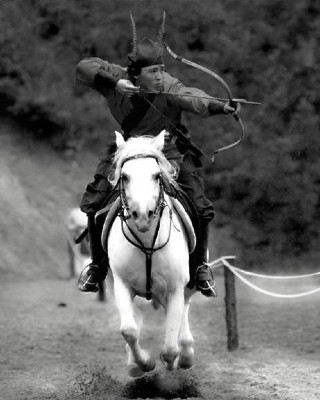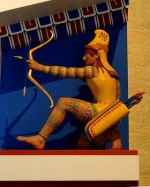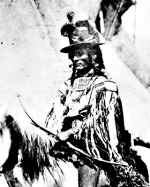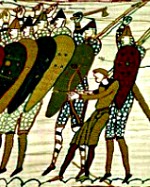The History of Archery in Korea
Talk the Talk
Traditional archery in the Korean military used a bow
called a gakgung (meaning horn bow).
It measures one metre in height and can shoot an arrow up to one hundred and forty-five metres.
Walk the Walk
Traditional archery in Korea has had attached to it a set of ethical beliefs that are largely drawn from the teachings of Confucius.
For example, the elite warriors of ancient Korea known as the Hwarang were trained in the literary arts as well as military pursuits and were taught to live by five major precepts.
Loyalty to the monarch
Filial piety to parents
Amicability among friends
No retreat in war
Aversion to unnecessary killing
Ethical teachings were a fundamental factor in the history of Korean archery and this has lasted throughout the ages.
Even today, Korean archery has a strong emphasis on courtesy, etiquette and on mental focus.

The history of archery in Korea stretches back virtually uninterrupted to prehistoric times. Tribal warlords are known to have been using mounted archers in their armies from at least the fifth century BCE and archery was an integral part of the Korean military right up to the nineteenth century.
Ancient Archery History in Korea
Ancient Archers were instrumental in the conflicts during the Three Kingdom Period of Korean history (57 BCE to 668 CE), during which time the country went from having numerous tribal states to having three main kingdoms.
By the end of this period, the Silla Kingdom defeated the Baekje and Koguryo Kingdoms, bringing unification to the country for the first time.
To do this they trained young men to become the ideal solders, called Hwarang (Flower Knights), they would often ride into battle on horseback shooting their arrows as they rode (represented in the photo to the right).
The Silla were able to defeat their rivals as they had help from the Chinese Tang army, however, they soon wanted total independence rather than being a nation that paid tributes to China and by
735, they would use elite archery to help push the Chinese out of Korea.
Making a Korean Bow
For centuries, the gakgung (horn bow) was the weapon of choice for traditional archers in Korea. Unusually, it was a reflex bow as opposed to the more common recurve model. This means that as with the recurve, the ends of the bow curve away from the archer when it is strung but when
unstrung, the bow was made to curve into a C shape when making a Korean bow, greatly increasing the power it can generate.
The gakgung was a composite
bow with a core made from sinew-backed bamboo, the handle would be made of oak and water buffalo horn would be used on the belly. The outer ends of the limbs could be comprised of either mulberry
or acacia and were v-splice onto the bamboo. The glue was made from fish air bladder and over the sinew backing was a special birch bark that was imported from Northeast China and soaked in
seawater for around a year.
The body of the arrow was also made of bamboo, the point made of iron and
the fletching came from pheasant’s feathers. The nock was made from bush clover and secured with sinew and along with the fletching, held on with fish air bladder glue. In traditional Korean archery, the Mongolian Draw is employed which means the archer draws the
string using his or her thumb and index finger (as opposed to the Mediterranean Draw which uses the first three fingers). To hold the string, the arched would use a gahk jee, which is a
teardrop-shaped thumb ring made from ox horn that prevents the thumb from getting damaged upon release of the string.
The Japanese Invasion
In the sixteenth century, Japan invaded the country and the traditional archery of the Korean military would be vital. The war saw many lives lost on both sides but Korea eventually won through, largely as a result of employing archers to rain down lethal salvos of arrows on their opponents at long range. After this, civilian shooting ranges began to appear in the country as a way of training the population against potential future invasions and to further enhance the tradition of martial and ritual archery in Korea.
The Decline of Archery in the Korean Military
During the nineteenth century, as was the case with other countries in East Asia, Korea wanted to stay isolated from the rest of the world but was under attack from countries in the West wishing to establish trade links with them. However, despite valiant efforts, they would soon be forced into modernization and trading with the West.
This period saw a major change in archery in Korea as the use of the bow and arrow within the military was gradually replaced on the battlefield by the firearm. By the twentieth century, Korean archery was no longer employed by the armed forces but remained important to the culture of the country, though now more as an athletic event.
South Korean Archery in the Modern Era
Today in South Korea, archery is still one of the most loved pastimes and the county excels at the sport, boasting many of the top-ranked competitors in the world. Children start learning in primary school and can practice up to two hours a day. The best young archers then receive high-quality coaching through high school and college, generating for the country a deep pool of talent that has led to South Korea being the best in the world at the sport in the latter half of the twentieth century and on into the twenty-first.
John Stanley, a World Archery correspondent stated that this system has, “been in place for decades with one ultimate goal in mind: bringing home Olympic medals.”
The effectiveness of this emphasis on learning to use the bow within the education system is indeed highlighted when looking at Olympic archery history; in the 2016 Rio Olympics, South Korea won gold medals in all four categories, men’s and women’s team and individual.
They have taken gold in every women’s (recurve) event since women’s archery became a part of the Olympics in 1988 at Seoul and the men and women combined have taken thirty-nine Olympic medals, twenty-three of which are gold (up to and including the 2016 games).; they took another four gold medals in the 2020 Olympic Games in Tokyo.
In order to achieve this dominance, the elite South Korean archers train up to ten hours a day come rain or shine and can shoot over two and a half thousand arrows in practice each week, as well as constantly striving to improve their mental strength and focus.
The ancient tradition of archery lives on in South Korea through its application as a sport and the people there take great pride in being home to the best world archery has to offer.
Written by Andrew Griffiths – Last updated 27/06/2023. If you like
what you see, consider following the History of Fighting on social media.
Further Reading:
Duvernay, T. [Internet]. 2020. Korean Traditional Archery. atarn.org. Available from: http://www.atarn.org/korean/korean1.htm [Accessed July 19, 2020].
Duvernay, T. [Internet]. 1997. The Way of the Bow. atarn.org. Available from: http://www.atarn.org/korean/IA_kr_1.htm [Accessed July 19, 2020].
Johnson, T. [Internet]. 2016. 4 Reasons Korea Dominates Archery. archery360.com. Available from: https://www.archery360.com/2016/11/02/4-reasons-korea-dominates-archery [Accessed July 19, 2020].
Korean Bow. [Internet]. 2015. antiquealive.com. Available from: http://www.antiquealive.com/Blogs/Korean_Bow.html [Accessed July 19, 2020].
More Archery History
Archery History Home
The bow and arrow has been used since at least the Palaeolithic Era (late Stone Age) and the earliest known composite bow was used in Egypt c.2800 BCE. Ancient and medieval archery were used for hunting and warfare though with the invention of the firearm, modern archery has developed into a popular sport that is enjoyed all over the world.
The bow and arrow has been used since at least the Palaeolithic Era (late Stone Age) and the earliest known composite bow was used in Egypt c.2800 BCE. Ancient and medieval archery were used for hunting and warfare though with the invention of the firearm, modern archery has developed into a popular sport that is enjoyed all over the world.
Mongolian Archery
The history of Mongolian archery dates back for thousands of years and has been used for hunting, sport and warfare. The Mongolian bow was one of the most powerful hand-held weapons in the world up to the modern era and helped Genghis Khan and his descendants build one of the largest empires the world has ever seen.
The history of Mongolian archery dates back for thousands of years and has been used for hunting, sport and warfare. The Mongolian bow was one of the most powerful hand-held weapons in the world up to the modern era and helped Genghis Khan and his descendants build one of the largest empires the world has ever seen.
Making the Native American Bow and Arrow
The making of the Native American bow and arrow was a complex, time consuming process. Various different materials were used depending on what was available to the craftsman, but each weapon had to be made to a high standard as it would provide a Native American warrior and his tribe food when used for hunting and protection when used in battle.
The making of the Native American bow and arrow was a complex, time consuming process. Various different materials were used depending on what was available to the craftsman, but each weapon had to be made to a high standard as it would provide a Native American warrior and his tribe food when used for hunting and protection when used in battle.
Archery History in Medieval England
Archery history in England saw the use of various forms of bow and arrow, including the short bow, crossbow and the medieval longbow. While the medieval short bow’s usefulness on the battlefield was limited, the crossbow and later the longbow helped English forces defeat much larger opponents which ultimately led to medieval archers gaining respect and prestige.
Archery history in England saw the use of various forms of bow and arrow, including the short bow, crossbow and the medieval longbow. While the medieval short bow’s usefulness on the battlefield was limited, the crossbow and later the longbow helped English forces defeat much larger opponents which ultimately led to medieval archers gaining respect and prestige.
The images on this site are believed to be in the public domain, however, if any mistakes have been made and your copyright or intellectual rights have been breeched, please contact andrew@articlesonhistory.com.




